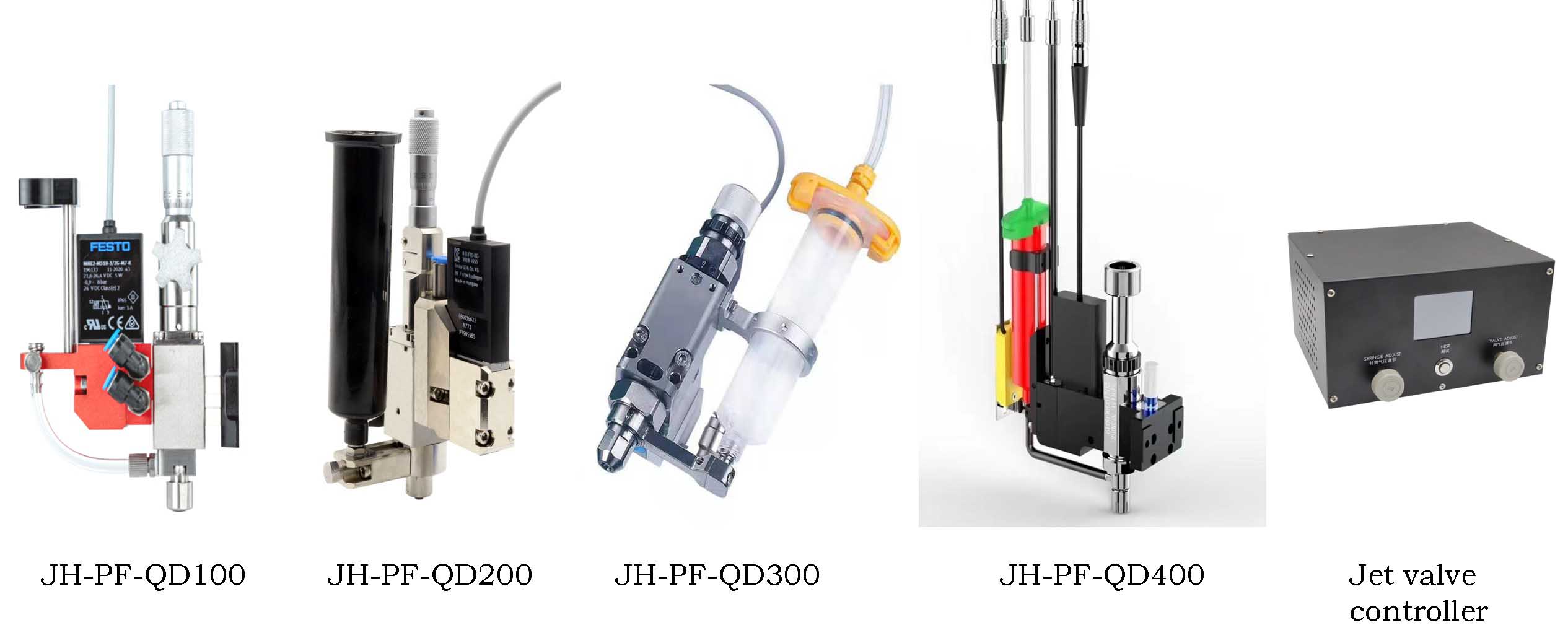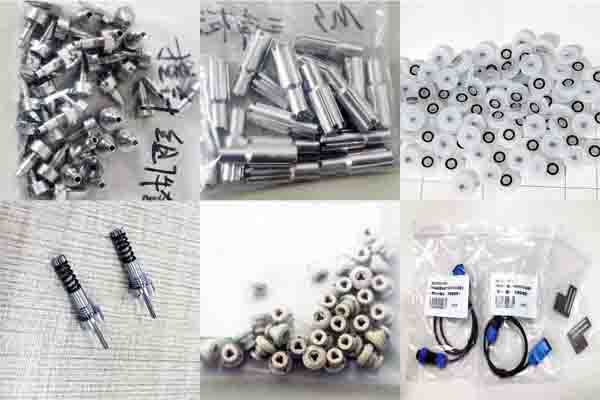Product Number:APJ1006 & APJ1021 & APJ1019 & APJ5007
Product Usage:Applicable to mainstream epoxy resin dispensing machines such as JHIMS, Nordson, Asymtek, Techcon, Vermes, Axxon, GKG, Mingseal, GK-PRETECH, Anda, etc.
Applicable Industries:1、Electronic assembly 2、Semiconductor packaging 3、Automobile manufacturing 4、Medical devices

National Advisory Hotline:
+86 18975335491JHIMS provides high-quality spare parts for epoxy resin dispensing nozzle assemblies. Our components are designed for durability and precision, compatible with leading brands such as Nordson, Asymtek, Techcon, Vermes, Axxon, GKG, Mingseal, GK-PRETECH, and Anda. Ideal for applications in electronics, automotive, and medical industries.
Due to the wide variety of nozzles and tappets used in dispensing machines, specifications and brands vary. This page showcases a selection of our products. For specific nozzles, tappets, or dispensing valve parts, please contact our customer service.

The needle, seal, valve body, and other parts of the epoxy resin dispensing valve are core components, ensuring precise dripping, flow control, and sealing performance. Their quality and design directly impact the accuracy, stability, and lifespan of epoxy resin dispensing. Below is a detailed introduction to these key parts:
The needle directly contacts the glue, controlling its release and flow. For high-viscosity materials like epoxy resin, the needle’s design is critical.
Function: Controls glue outflow and flow rate, typically consisting of a needle head and seat. The needle head’s opening size determines the dispensed glue amount.
Material: Made from corrosion- and wear-resistant materials like stainless steel, hardened steel, or ceramic, ensuring resistance to epoxy resin’s high viscosity and adhesion.
Design Type: Includes round hole nozzles, needle nozzles, and micro needles. Precision dispensing applications use smaller, high-precision needles for fine dispensing.
Cleaning Issues: High-viscosity epoxy can clog needles. Designs facilitate easy cleaning, often with automatic systems to reduce maintenance.
Seals prevent glue leakage and protect the system under high pressure and adhesive conditions.
Function: Ensure sealing inside and outside the valve body, located at valve body joints, needle-valve interfaces, and glue supply connections.
Material: High-temperature and corrosion-resistant materials like fluororubber (FKM), silicone, or PTFE withstand chemical solvents and heat.
Application Locations: Between needle and valve body, valve body and pneumatic actuator, and pumping system joints to prevent leakage.
Importance: Good seals prevent glue leakage and air ingress, ensuring dispensing stability. Regular checks and replacements are essential.
The valve body is the core structure, supporting components like the needle and seals.
Function: Houses components, transmits air pressure or electricity to control glue flow, and provides seal positioning for system sealing.
Material: High-strength, corrosion-resistant metals like stainless steel (304 or 316) or aluminum alloy, sometimes hard-anodized for durability.
Design Requirements: High-precision processing, high-temperature and chemical resistance, and easy maintenance for regular cleaning.
The piston pushes glue flow, controlling delivery in piston dispensing valves.
Function: Reciprocates inside the valve body to control glue release, with position and speed adjusted via air pressure or electricity.
Material: Wear- and corrosion-resistant metals or plastics, tightly fitted to prevent leakage, often with corrosion-resistant sealing rings.
The valve seat works with the needle to prevent glue leakage when closed.
Function: Ensures sealing during valve closure, used with seals for high sealing performance.
Material: Wear- and corrosion-resistant metals or synthetic materials, sometimes coated for enhanced durability.
The adjustment screw fine-tunes glue flow and pressure.
Function: Located outside the valve, adjusts the valve opening to control glue flow via bolt rotation.
Material: Corrosion-resistant metals like stainless steel or alloys for stability in epoxy resin environments.
The cleaning system removes residual epoxy to prevent clogging.
Components: Automatic cleaning devices using airflow or solvent injection, and solvents like alcohol or acetic acid for residue removal.
Importance: Ensures valve cleanliness before each dispensing cycle, maintaining performance.
.jpg)
Features:
Technical Parameters:
Advantages: Low cost, easy to process, corrosion-resistant.
Disadvantages: Lower wear resistance, suited for low-frequency or low-viscosity tasks.
Applications: General dispensing tasks with low-viscosity materials like water-based glue.
Features:
Technical Parameters:
Advantages: Excellent wear and impact resistance, high precision.
Disadvantages: Higher cost, brittle under high impact.
Applications: High-viscosity or high-pressure tasks like electronic packaging.
Features:
Technical Parameters:
Advantages: High precision, temperature tolerance.
Disadvantages: Brittle, high cost, difficult to process.
Applications: Semiconductor packaging, optical components.


Features:
Technical Parameters:
Advantages: High density, wear resistance, long-term stability.
Disadvantages: Heavy, high cost.
Applications: High-frequency, precision dispensing in automated lines.
Features:
Technical Parameters:
Advantages: Unmatched wear resistance, precision.
Disadvantages: Very high cost, brittle, difficult to process.
Applications: Semiconductor packaging, microelectronics.
Features:
Common Materials:
Advantages: Low cost, good chemical resistance.
Disadvantages: Poor wear resistance, limited temperature range.
Applications: Low-viscosity glue, thin-layer coating.
| Material | Hardness | Tensile Strength | Temperature Resistance | Wear Resistance | Cost | Recommended Applications |
|---|---|---|---|---|---|---|
| Stainless Steel | 200-250 HV | 500-600 MPa | Room Temperature | Low | Low | General dispensing tasks, low-viscosity adhesives |
| Hardened Steel | 55-60 HRC | 700-900 MPa | Room Temperature | High | Medium | High-frequency, high-pressure dispensing tasks |
| Ceramic | 900-1500 HV | 200-400 MPa | 200°C-300°C | Extremely High | High | High-precision, high-viscosity, high-temperature applications |
| Tungsten Alloy | 500-700 HV | 700-800 MPa | Room Temperature | Extremely High | High | High-frequency, high-load, high-precision dispensing |
| Diamond | 3000 HV | Low | >800°C | Extremely High | Very High | Ultra-precise, high-frequency, high-viscosity adhesives |
| POM | 120-150 HV | 60-80 MPa | -40°C to 100°C | Medium | Low | Low-load, low-temperature, chemically stable environments |
| PEEK | 200-250 HV | 90-100 MPa | -50°C to 250°C | Medium | High | High-temperature, strength-demanding dispensing tasks |
| Nylon | 100-150 HV | 60-80 MPa | -30°C to 100°C | Medium | Low | Low-load, low-temperature applications |
These spare parts are ideal for:
For inquiries, reach out at: +86 18975335491 or visit our contact page.
